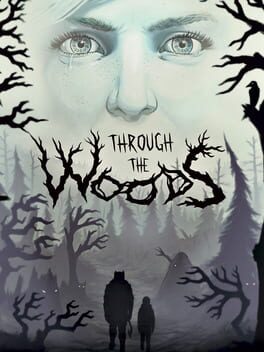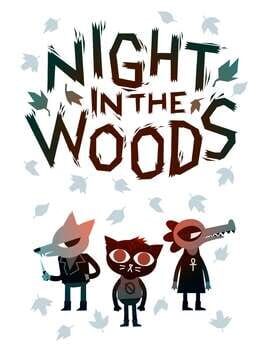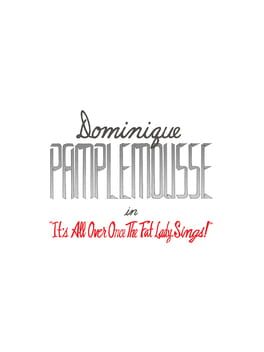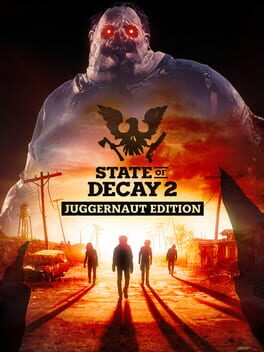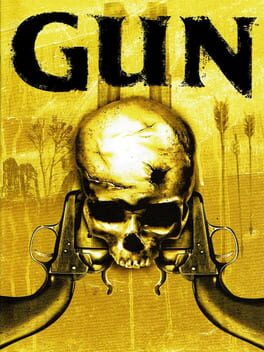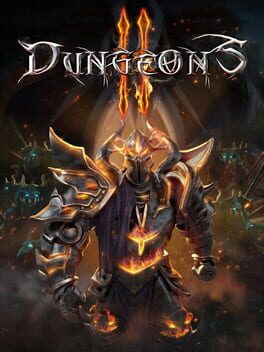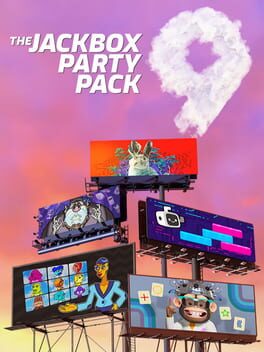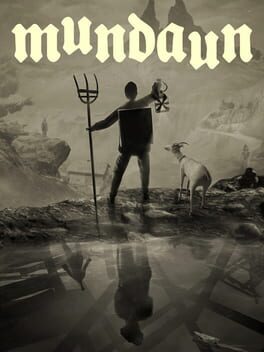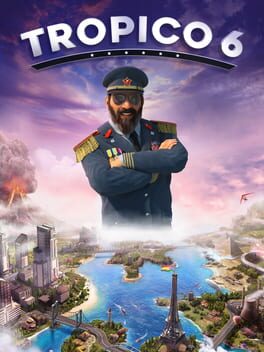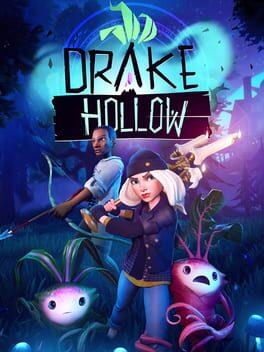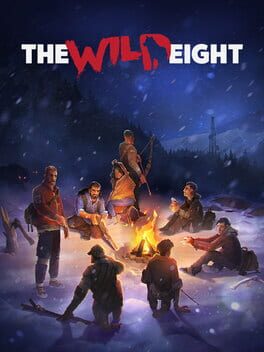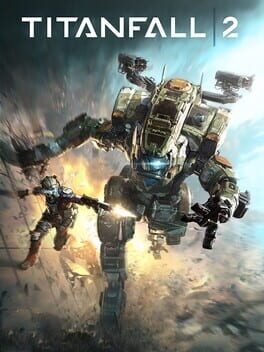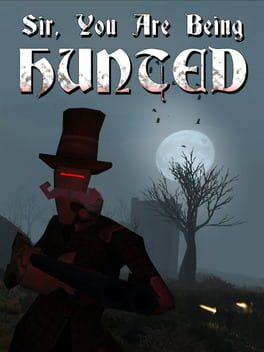astarrgames
2016
This review contains spoilers
Played and written October 30, 2020:
I played and finished this on stream for spooooooky October and had conflicting feelings about it.
I'm playing with English audio, which may have an impact. Overall, I found the environment and monsters great and scary! However, I have huge problems with the story and characters.
I didn't know what to expect going into this, and was really creeped out as the sun sank going through what seemed like an abandoned village. There was good suspense building up to the encounters, and meeting the creatures had been creepy but intriguing. It looks beautiful, the skyline and how it changes throughout the story is impactful, and the sound design really fit well with the environment and added to the eeriness of the world.
The game is a little clunky and stiff, as walking over rocks or other objects really impacts the character's position in camera and the camera perspective. I also believe I had an encounter that was bugged, where I believe a monster was supposed to kill me but I walked through them a bunch of times - there's an achievement to die from them from what I gathered.
After a while, the protagonist became frustrating. There are audio lines that sound and feel unrealistic considering what I've experienced already in the storyline. For example, I don't know if playing with English audio had an impact on the poor quality voice acting or the rhythm of dialogue, but I felt like a few things were delayed or did not make contextual sense.
While that stuff I could laugh off and still be convinced I was in a horrifying world, there are politics in this. The protagonist's backstory is brought up at the climax, which unfortunately reinforces my dislike of the character I'm playing. Her story is
There are a lot of problems to unpack with this climatic story line. I gave the benefit of a doubt to the writers and looked up local Norway statistics and analysis of this, but this narrative has the same problems if it were written in North America. While I can absolutely remove this game from reality and our real lives, there is an huge problem with telling fictitious stories that involve real life social issues and use myths raised by Edit: Also, how did I forget that every time
There are ways to talk about these tropes, but how it was handled here really turned me off of the game. This plot line reminded me so much of The Room I think I exclaimed it out loud on stream and just pushed to finish it. It's also what tipped me off to not recommend this, otherwise I would have felt this was a fine scare for a little bit with some clunkiness.
I played and finished this on stream for spooooooky October and had conflicting feelings about it.
I'm playing with English audio, which may have an impact. Overall, I found the environment and monsters great and scary! However, I have huge problems with the story and characters.
I didn't know what to expect going into this, and was really creeped out as the sun sank going through what seemed like an abandoned village. There was good suspense building up to the encounters, and meeting the creatures had been creepy but intriguing. It looks beautiful, the skyline and how it changes throughout the story is impactful, and the sound design really fit well with the environment and added to the eeriness of the world.
The game is a little clunky and stiff, as walking over rocks or other objects really impacts the character's position in camera and the camera perspective. I also believe I had an encounter that was bugged, where I believe a monster was supposed to kill me but I walked through them a bunch of times - there's an achievement to die from them from what I gathered.
After a while, the protagonist became frustrating. There are audio lines that sound and feel unrealistic considering what I've experienced already in the storyline. For example, I don't know if playing with English audio had an impact on the poor quality voice acting or the rhythm of dialogue, but I felt like a few things were delayed or did not make contextual sense.
While that stuff I could laugh off and still be convinced I was in a horrifying world, there are politics in this. The protagonist's backstory is brought up at the climax, which unfortunately reinforces my dislike of the character I'm playing. Her story is
There are a lot of problems to unpack with this climatic story line. I gave the benefit of a doubt to the writers and looked up local Norway statistics and analysis of this, but this narrative has the same problems if it were written in North America. While I can absolutely remove this game from reality and our real lives, there is an huge problem with telling fictitious stories that involve real life social issues and use myths raised by Edit: Also, how did I forget that every time
There are ways to talk about these tropes, but how it was handled here really turned me off of the game. This plot line reminded me so much of The Room I think I exclaimed it out loud on stream and just pushed to finish it. It's also what tipped me off to not recommend this, otherwise I would have felt this was a fine scare for a little bit with some clunkiness.
2019
What stands out most is the writing and RPG mechanics.
There's a lot of reading and complimentary voice acting to introduce characters or scripted segments. The writing describes the fantasy world in Disco Elysium, the characters you talk to, and a lot of dialogue. I think this is why there were some negative reviews of DE, so know what you're signing up for. The game is conversations and dice-rolling to determine if you're achieving an action or dialogue option, then walking to another area to do the same with an invisible timer.
The fantasy world of DE is fantasy. There are some parallels to our real world geopolitically and there is some conversation between the two worlds definitely, but they're not all direct. Non-spoiler example is the reference to a political philosopher in the world of DE, Kras Mazov, who is almost a direct reference to Karl Marx. However these are not always direct references or placeholders and stand-ins our world and it shouldn't be read as such. So, DE can be accessible without knowledge of our own social or political histories here on Earth, which is a benefit for a non-history buff who wants to play a detective RPG. The story and the world feel complete and lived in, which also makes me excited for more stories in the Disco Elysium universe.
The characters are defined as such that you can fit the role of someone who admires or detests them, as well as the player's feelings towards them. You'll talk to people a lot, and that is the game, and where the writing is forefront. You can learn about your character and play their role, with just a little continuity errors - as events happen or you take on a persona, so do the conversations. It's the first option, but I really recommend Encyclopedia as a first character so you learn more about the world as you discover your character.
The gameplay is a bit of running around, figuring out places to go, more people to talk to, trying to resolve an issue, hitting a wall, gaining experience and trying again. It is almost a "bottle episode" where you're on the same coastline town between a few buildings for the entirety of the game, but there is so much happening, with many subplots and metaphorical (and actual) doors opening that every day or level-up you gain will feel like a new place. When the story resolves, it's absolutely possible to replay the game and discover or complete quests you didn't have access to, play in the new Hardcore Mode, and role play as an absolutely different person.
The artwork is a watercolour expressionist that is beautiful to look at, which you'll be looking at a lot of the same landscape. Watch a bit to see if you like and understand what you're looking at. There's also a helpful highlights over objects and people can be interacted with, and some animated sequences to add variation to the flow of the game. There is minor tearing when zooming out or changing animations, which is barely noticeable and doesn't impact the gameplay. The music is also very well done to be both interesting and ambient, so that the loop doesn't become annoying or frustrating. You feel when you're in a dance-y or lounge-y spot, or you feel like you're on coastline because of the ambience sounds.
I really felt DE was an emotional roller coaster with humorous bits deriving from situations or dialogue, frustrating because you're dealing with someone or something you want to respond to outside of your role, sad because of how awful and sad everyone and the world can be, and satisfying when you start to check-off in-game goals. I'm not very experienced in detective games and plan on diving into them now after playing through DE, so I'm not sure if this is an introductory game in the genre, but as a stand-alone game it is absolutely worth the play through.
There's a lot of reading and complimentary voice acting to introduce characters or scripted segments. The writing describes the fantasy world in Disco Elysium, the characters you talk to, and a lot of dialogue. I think this is why there were some negative reviews of DE, so know what you're signing up for. The game is conversations and dice-rolling to determine if you're achieving an action or dialogue option, then walking to another area to do the same with an invisible timer.
The fantasy world of DE is fantasy. There are some parallels to our real world geopolitically and there is some conversation between the two worlds definitely, but they're not all direct. Non-spoiler example is the reference to a political philosopher in the world of DE, Kras Mazov, who is almost a direct reference to Karl Marx. However these are not always direct references or placeholders and stand-ins our world and it shouldn't be read as such. So, DE can be accessible without knowledge of our own social or political histories here on Earth, which is a benefit for a non-history buff who wants to play a detective RPG. The story and the world feel complete and lived in, which also makes me excited for more stories in the Disco Elysium universe.
The characters are defined as such that you can fit the role of someone who admires or detests them, as well as the player's feelings towards them. You'll talk to people a lot, and that is the game, and where the writing is forefront. You can learn about your character and play their role, with just a little continuity errors - as events happen or you take on a persona, so do the conversations. It's the first option, but I really recommend Encyclopedia as a first character so you learn more about the world as you discover your character.
The gameplay is a bit of running around, figuring out places to go, more people to talk to, trying to resolve an issue, hitting a wall, gaining experience and trying again. It is almost a "bottle episode" where you're on the same coastline town between a few buildings for the entirety of the game, but there is so much happening, with many subplots and metaphorical (and actual) doors opening that every day or level-up you gain will feel like a new place. When the story resolves, it's absolutely possible to replay the game and discover or complete quests you didn't have access to, play in the new Hardcore Mode, and role play as an absolutely different person.
The artwork is a watercolour expressionist that is beautiful to look at, which you'll be looking at a lot of the same landscape. Watch a bit to see if you like and understand what you're looking at. There's also a helpful highlights over objects and people can be interacted with, and some animated sequences to add variation to the flow of the game. There is minor tearing when zooming out or changing animations, which is barely noticeable and doesn't impact the gameplay. The music is also very well done to be both interesting and ambient, so that the loop doesn't become annoying or frustrating. You feel when you're in a dance-y or lounge-y spot, or you feel like you're on coastline because of the ambience sounds.
I really felt DE was an emotional roller coaster with humorous bits deriving from situations or dialogue, frustrating because you're dealing with someone or something you want to respond to outside of your role, sad because of how awful and sad everyone and the world can be, and satisfying when you start to check-off in-game goals. I'm not very experienced in detective games and plan on diving into them now after playing through DE, so I'm not sure if this is an introductory game in the genre, but as a stand-alone game it is absolutely worth the play through.
2017
This was fun! The voices and music were very creative and well put together. It's really based on whether you enjoy music, so I can't recommend it for everyone, but it is a well-written and funny short game. There's not much in the way of puzzles and mechanics, with the exception of two points where I couldn't resolve by simply clicking down the dialogue tree.
I played solo, which was probably a determent to the game. I played through two maps and increased the difficulty between them. I also think I came in after a couple of quality-of-life updates, which I looked up and it seemed like this was the right time to play it.
It's a very well-designed zombie game that has great mechanisms in place to escalate the feelings of dread, desperation and endless, uphill battle a zombie apocalypse should feel like. It has great a community and base-building aspect that adds to this, where infighting and sacrifice are necessary and important parts to survival.
However, it's pushing against repetition, after two maps I considered myself finished with the game. The changes to the environment, where to build a base or take resourceful locations, alongside the limited zombie and mission types, there's not much to force a change of gameplay or encourage me to increase difficulties and start a new community in another map.
It's a very well-designed zombie game that has great mechanisms in place to escalate the feelings of dread, desperation and endless, uphill battle a zombie apocalypse should feel like. It has great a community and base-building aspect that adds to this, where infighting and sacrifice are necessary and important parts to survival.
However, it's pushing against repetition, after two maps I considered myself finished with the game. The changes to the environment, where to build a base or take resourceful locations, alongside the limited zombie and mission types, there's not much to force a change of gameplay or encourage me to increase difficulties and start a new community in another map.
2005
2015
Yep. This is the spiritual successor of Dungeon Keeper, and if they continued the franchise this is what the third installment would look like. Although there are significant differences between the two, while this one feels expansive and limited in direct comparison.
For anyone not familiar with Dungeon Keeper, Dungeons allows you to have an almost-absolute control over an underground base while full control over surface battles outside of your base. You are able to control 2 different factions of dungeon builders (3 in skirmish mode) who come with their own kinds of rooms and half-dozen different kinds of units.
It feels like a tower defense game (unlike Dungeon Keeper) because there are regular raids on your dungeon, forcing you to create defenses. However, you can't progress your unit's levels or builds without going out of your dungeon to explore and destroy your above-ground enemies.
One thing I didn't like about the campaign was that it feels a lot like a very closely guided tutorial until the last couple of missions. It would have been nice to learn in one map, then have freedom to explore and come up with unique ways to fight your enemies.
The world and narration is fun and entertaining, however I had to reduce how often the narrator heckled me or made meta-game comments. The combat and spells you can use against your enemies really feels good when you are levelled up, because of how each unit can progress through different skill lines and compliment each other.
It's great if you like strategy games with very short learning curves and playing-as-the-enemy aesthetics. If you loved Dungeon Keeper like I did, this is a must.
For anyone not familiar with Dungeon Keeper, Dungeons allows you to have an almost-absolute control over an underground base while full control over surface battles outside of your base. You are able to control 2 different factions of dungeon builders (3 in skirmish mode) who come with their own kinds of rooms and half-dozen different kinds of units.
It feels like a tower defense game (unlike Dungeon Keeper) because there are regular raids on your dungeon, forcing you to create defenses. However, you can't progress your unit's levels or builds without going out of your dungeon to explore and destroy your above-ground enemies.
One thing I didn't like about the campaign was that it feels a lot like a very closely guided tutorial until the last couple of missions. It would have been nice to learn in one map, then have freedom to explore and come up with unique ways to fight your enemies.
The world and narration is fun and entertaining, however I had to reduce how often the narrator heckled me or made meta-game comments. The combat and spells you can use against your enemies really feels good when you are levelled up, because of how each unit can progress through different skill lines and compliment each other.
It's great if you like strategy games with very short learning curves and playing-as-the-enemy aesthetics. If you loved Dungeon Keeper like I did, this is a must.
Like with every Jackbox, most of the enjoyment of the game comes from the people you play with. That written, the games included in the Jackbox Party Packs need the prompts and mechanisms that allow for people to get together and have fun. Jackbox 9 overall does a decent job of this, but with some issues.
Fibbage 4 is a sequel to a previous game series and doesn't divert away from the formula. They've included a new style of prompt (a video) and edited out a final prompt in the mini-mini-game Enough About You - which my friends actually prefer. It's a well done quiz game with plenty of fun and exciting contributions from both the game and players.
Quixort is the new trivia game that is sorting answers. It's a strange choice, as the trivia games included in previous party packs (You Don't Know Jack, Trivia Murder Party and The Wheel) were exceptionally well done. The player needs to sort answers on their phone using a Tetris-like block placed on a line, which is confusing to some people I've played with, leading to some difficulty that wasn't fun. As well, the final round makes the player replay their final prompt, which is an interesting decision, but ultimately leaves anyone I've played with frustrated and disappointed. The game also has the unfortunate problem of making a second player or group of players wait for another team to finish playing the game for a long time - unlike most of the other trivias.
Junktopia is also one of the least favourite among my friends and family. It was a forgettable experience, as everyone had to ask whether we've already played it or not. Part of the issue is that the player's contributions are simply two prompts regarding an item they're describing. Other Jackbox games use this feature (Survive the Internet) but give some variation to the purpose of writing prompts. This game, again, makes the unfortunate choice of repeating the final prompt - bringing all of your previous items together to just name them. This makes the game repetitive with a longer period of time without engaging in unique or creative input from players.
Nonsensory is a surprisingly fun and enjoyable game. It reminded us of Guesspionage (JBPP3), as players attempt to find the hidden value (between 1-10 mostly) of a prompt. Players each make their own content which others guess at. This leads to much more excitement and engagement from everyone involved.
Finally, Roomerang is an interesting and well-designed game. It requires the players to role-play a character, which my group doesn't actually do - and instead treating the game like a Quiplash, where we vote the funniest prompts. Despite human error, this game does have one striking fault, which is that players produce so much content in the game that is not very well visible, or immediately erased from the screen after showing them. Our group typically adds more time to answering prompts, but there wasn't an option to extend viewing the responses, which is what we would have needed.
Despite all of that, the Jackbox Games continue to be some of the most fun party games that are accessible to all sorts of groups, as long as they have smartphones. I still highly recommend this, if not just for half of the games included for their exceptional design. Players will still need to bring others into their games to find out what is fun and how they can all enjoy the games together.
Fibbage 4 is a sequel to a previous game series and doesn't divert away from the formula. They've included a new style of prompt (a video) and edited out a final prompt in the mini-mini-game Enough About You - which my friends actually prefer. It's a well done quiz game with plenty of fun and exciting contributions from both the game and players.
Quixort is the new trivia game that is sorting answers. It's a strange choice, as the trivia games included in previous party packs (You Don't Know Jack, Trivia Murder Party and The Wheel) were exceptionally well done. The player needs to sort answers on their phone using a Tetris-like block placed on a line, which is confusing to some people I've played with, leading to some difficulty that wasn't fun. As well, the final round makes the player replay their final prompt, which is an interesting decision, but ultimately leaves anyone I've played with frustrated and disappointed. The game also has the unfortunate problem of making a second player or group of players wait for another team to finish playing the game for a long time - unlike most of the other trivias.
Junktopia is also one of the least favourite among my friends and family. It was a forgettable experience, as everyone had to ask whether we've already played it or not. Part of the issue is that the player's contributions are simply two prompts regarding an item they're describing. Other Jackbox games use this feature (Survive the Internet) but give some variation to the purpose of writing prompts. This game, again, makes the unfortunate choice of repeating the final prompt - bringing all of your previous items together to just name them. This makes the game repetitive with a longer period of time without engaging in unique or creative input from players.
Nonsensory is a surprisingly fun and enjoyable game. It reminded us of Guesspionage (JBPP3), as players attempt to find the hidden value (between 1-10 mostly) of a prompt. Players each make their own content which others guess at. This leads to much more excitement and engagement from everyone involved.
Finally, Roomerang is an interesting and well-designed game. It requires the players to role-play a character, which my group doesn't actually do - and instead treating the game like a Quiplash, where we vote the funniest prompts. Despite human error, this game does have one striking fault, which is that players produce so much content in the game that is not very well visible, or immediately erased from the screen after showing them. Our group typically adds more time to answering prompts, but there wasn't an option to extend viewing the responses, which is what we would have needed.
Despite all of that, the Jackbox Games continue to be some of the most fun party games that are accessible to all sorts of groups, as long as they have smartphones. I still highly recommend this, if not just for half of the games included for their exceptional design. Players will still need to bring others into their games to find out what is fun and how they can all enjoy the games together.
2021
Usually when I talk to others who have played this game, we come to the conclusion that it's "an adventure game with horror in it" and that horror is typically a deep sense of dread. That dread is well written in to the story of the game, in which I feared for the town, the people and myself while uncovering the mysteries within Mundaun. I could always feel like worse and worse things would happen in this world, and that there could not be a resolution.
The art style is the immediate selling point of this game, although everything else about it is fantastic. I thought the black-and-white / sepia tones would be boring or ugly to look at for hours, but it is both unique and has been beautifully used throughout lands. There is a distinction between regions you enter and the skybox is typically always visible and gorgeous.
Beyond the artistic choice, what gives this game outstanding visual style is how that the way the player is drawn to environmental scripted moments. There are things that happen throughout the game that you could miss if you weren't watching, and I almost did, but there is a particular way these moments pop out of the background, or the players focus gets pulled to them. I don't know how to explain it, but when these moments happen it is startling and mesmerizing!
Mechanically, the game is a simple adventure, with an appropriate amount of verbs and interactions the player can make. It leans minimally on a survival-horror genre, with limited supplies to use against enemies, but doesn't rely entirely on them. I ended up exploring as much as I could, not because of collecting but because I was craving more storytelling.
This game is also really fun! I enjoyed driving around, meeting new people and walking around the world. I'm not big into adventure game puzzles as I can find them either too easy and boring or too difficult and frustrating. Mundaun found a happy-medium, where every next objective was explained when necessary. If I found something I could interact with and didn't understand, I would eventually be told how I could use it when needed. I didn't end up backtracking a lot to figure out if I forgot or missed something, it wasn't much and did not feel like a chore, as the vehicle is fun, the land is nice to look at, and the creepiness of some environments is pleasant to pass through.
Mundaun is a wonderful game, and after beating it, wanted to revisit for another possible ending - or just to be in this world again, find the secrets I may have missed and be amazed by the visual moments I may have forgotten about. I can't recommend this game enough.
The art style is the immediate selling point of this game, although everything else about it is fantastic. I thought the black-and-white / sepia tones would be boring or ugly to look at for hours, but it is both unique and has been beautifully used throughout lands. There is a distinction between regions you enter and the skybox is typically always visible and gorgeous.
Beyond the artistic choice, what gives this game outstanding visual style is how that the way the player is drawn to environmental scripted moments. There are things that happen throughout the game that you could miss if you weren't watching, and I almost did, but there is a particular way these moments pop out of the background, or the players focus gets pulled to them. I don't know how to explain it, but when these moments happen it is startling and mesmerizing!
Mechanically, the game is a simple adventure, with an appropriate amount of verbs and interactions the player can make. It leans minimally on a survival-horror genre, with limited supplies to use against enemies, but doesn't rely entirely on them. I ended up exploring as much as I could, not because of collecting but because I was craving more storytelling.
This game is also really fun! I enjoyed driving around, meeting new people and walking around the world. I'm not big into adventure game puzzles as I can find them either too easy and boring or too difficult and frustrating. Mundaun found a happy-medium, where every next objective was explained when necessary. If I found something I could interact with and didn't understand, I would eventually be told how I could use it when needed. I didn't end up backtracking a lot to figure out if I forgot or missed something, it wasn't much and did not feel like a chore, as the vehicle is fun, the land is nice to look at, and the creepiness of some environments is pleasant to pass through.
Mundaun is a wonderful game, and after beating it, wanted to revisit for another possible ending - or just to be in this world again, find the secrets I may have missed and be amazed by the visual moments I may have forgotten about. I can't recommend this game enough.
2019
This sequel could have been an update.
I started playing this series since Tropico 4, and had a real blast with Tropico 5. From T4 to T5, the distinctions between both games made me really debate which I preferred. Coming out of T5 and playing T6 though, I can't really tell the difference. It's almost like a "remaster" of T5 by a different developer, sticking true to a lot of the styling and mechanics of T5, but making subtle changes. I would probably recommend if you haven't played T5, maybe skip it and play this one instead if you get the chance - or if you have T5, stick to that.
Outside of comparing Tropico 6 to previous titles in the series, it's a wonderful city builder and management game. What Tropico offers in a city-builder is a somewhat less intense simulation experience, where micromanagement is often automated and many numbers are either hidden from the player's view or easy to follow. Those numbers you're watching are typically how favourable you are to residents of your islands and the flow of commerce between production and trading.
It's all wrapped up in a cartoony package, with humorous characters acting as your advisers and diplomats, giving you your missions. The issues arising from this are political comic caricatures that are cringey stereotypes or repetitive in their appearances or dialogue in a mission. The music is great and the game looks fine for a city-builder, but I've seen and watched some comparisons that show not much has changed between T5 and T6, some even suggesting that T6 has worse graphics despite being made 5 years later.
The missions are structured as individual scenarios and maps, while T5 had a campaign with persistent islands throughout it - for better or worse. I've actually only finished a couple of missions in T6, and may actually prefer this style as the campaigns can kind of feel like a constant tutorial. Each DLC adds a new map, but the missions for the base game state that DLC use "is experimental and can break the game" unlike previous Tropico games. I believe "break the game" means giving unfair advantages or disadvantages based on the DLC, but part of the fun and replay value in the other Tropico games was revisiting base game missions with the DLC on, giving little life to the newer DLC that only adds a single mission. I don't see much replay value in the T6 missions as they stand anyhow.
It's a very odd choice to make a Tropico so similar to its last installment, despite being 5 years apart. I will still recommend this, because it's a good game. For previous owners, it's not a real must-have until something significant changes or is added to the game - so far there isn't.
I started playing this series since Tropico 4, and had a real blast with Tropico 5. From T4 to T5, the distinctions between both games made me really debate which I preferred. Coming out of T5 and playing T6 though, I can't really tell the difference. It's almost like a "remaster" of T5 by a different developer, sticking true to a lot of the styling and mechanics of T5, but making subtle changes. I would probably recommend if you haven't played T5, maybe skip it and play this one instead if you get the chance - or if you have T5, stick to that.
Outside of comparing Tropico 6 to previous titles in the series, it's a wonderful city builder and management game. What Tropico offers in a city-builder is a somewhat less intense simulation experience, where micromanagement is often automated and many numbers are either hidden from the player's view or easy to follow. Those numbers you're watching are typically how favourable you are to residents of your islands and the flow of commerce between production and trading.
It's all wrapped up in a cartoony package, with humorous characters acting as your advisers and diplomats, giving you your missions. The issues arising from this are political comic caricatures that are cringey stereotypes or repetitive in their appearances or dialogue in a mission. The music is great and the game looks fine for a city-builder, but I've seen and watched some comparisons that show not much has changed between T5 and T6, some even suggesting that T6 has worse graphics despite being made 5 years later.
The missions are structured as individual scenarios and maps, while T5 had a campaign with persistent islands throughout it - for better or worse. I've actually only finished a couple of missions in T6, and may actually prefer this style as the campaigns can kind of feel like a constant tutorial. Each DLC adds a new map, but the missions for the base game state that DLC use "is experimental and can break the game" unlike previous Tropico games. I believe "break the game" means giving unfair advantages or disadvantages based on the DLC, but part of the fun and replay value in the other Tropico games was revisiting base game missions with the DLC on, giving little life to the newer DLC that only adds a single mission. I don't see much replay value in the T6 missions as they stand anyhow.
It's a very odd choice to make a Tropico so similar to its last installment, despite being 5 years apart. I will still recommend this, because it's a good game. For previous owners, it's not a real must-have until something significant changes or is added to the game - so far there isn't.
2020
This review contains spoilers
After playing The Molasses Flood's other game, The Flame and The Flood, I was very excited to play this when it was announced. I really enjoyed it, but I have a lot of stipulations. It's a cute game with an entertaining loop, but it's very minimal in every design. Granted, I played the entire game solo and could have been more positive playing coop.
This really is a hack-and-slash. You tap your melee attack 3 times to make a hacking combination and there is a single jump attack. It seems like they recently added parrying to the game before I played. The combat is absolutely minimal, with some actual diversity in the ranged attacks (about 5). You're to hack-and-slash around islands to clear out enemy structures while fighting off a few different enemy types vary as you progress, but again, only a small number of them (about 6?) which also simply has HP and damage increase per level.
The levelling system is based on your camp, and no new mechanics to the combat system are introduced when your level-up - only the numbers go up for both enemy HP and damage and your own weapon stats. Your companions increase in level when using materials you collect in the world, which increases the camp level and player health. The other statistic change that happens to the player is obtaining buffs from the inhabitants as they level up. Beyond numbers, nothing new really changes as the game progresses.
When camps level up, some new buildings are unlocked, and they perform a very minimal economy. There's water, food and entertainment for your inhabitants that buildings provide. Then there is defense and some auxiliary components to that economy - utility water and electricity to provide resources for upgraded buildings which produce water, food and entertainment. These camps are supplied by what you collect out in the world, which isn't very finite, as it looks like some materials repopulate and the rest are looted from enemies.
The game looks great and the music is good. Except, the music suddenly stops and becomes very absent most of the time you're exploring and suddenly starts again for almost no apparent reason.
So, the loop is: explore the world, hack-and-slash-and-block-and-parry enemies, gather materials, return to build the camp up or defend it from an incoming raid of enemies. Within this loop, you'll be given a quest to do something at a far off island every stage, whether that is read a note, go in a building, or fight an enemy, then return to camp for an end-stage raid (4 in total). Despite the repetition and simplicity, I really enjoyed this loop, which restarts every stage of the game.
I was fairly disappointed with how lacking the combat, building and crafting is, also with the ease in which I finished off the end boss, which [spoiler] is just another enemy your meet regularly later in the game [/spoiler]. Although, it kind of feels like just the right amount, which makes this game teeter between a positive and negative review.
Beating up enemies and blocking their attacks feels great, even though it's just 3 different swings! Expanding the camp for your inhabitants is very charming and enjoyable, sometimes fairly challenging if you're not getting the loot you need! I don't need to craft more than what the game is asking me to, and any more could have been a burden on the system. It actually benefits from its simplicity.
This game brings some interesting mechanics to a survive-and-build hack-and-slash game. Each island is surrounded by a death-fog that you'll need to both craft items to walk through it and build a very fun zip-line that acts as the game's fast travel. The inhabitants acting as your levelling up system is pretty unique from what I've seen, and changes the "grind" from killing-to-exp into killing-for-loot, which is slightly different as it encourages full land exploration. I also believe the maps are all procedural, which makes me curious to try this again on harder difficulties and drop into multiplayer games.
Some of this may change as new content is introduced into the game, but I wasn't entirely disappointed by this game and really felt good playing through it all. I look forward to more updates and getting friends into this to play!
This really is a hack-and-slash. You tap your melee attack 3 times to make a hacking combination and there is a single jump attack. It seems like they recently added parrying to the game before I played. The combat is absolutely minimal, with some actual diversity in the ranged attacks (about 5). You're to hack-and-slash around islands to clear out enemy structures while fighting off a few different enemy types vary as you progress, but again, only a small number of them (about 6?) which also simply has HP and damage increase per level.
The levelling system is based on your camp, and no new mechanics to the combat system are introduced when your level-up - only the numbers go up for both enemy HP and damage and your own weapon stats. Your companions increase in level when using materials you collect in the world, which increases the camp level and player health. The other statistic change that happens to the player is obtaining buffs from the inhabitants as they level up. Beyond numbers, nothing new really changes as the game progresses.
When camps level up, some new buildings are unlocked, and they perform a very minimal economy. There's water, food and entertainment for your inhabitants that buildings provide. Then there is defense and some auxiliary components to that economy - utility water and electricity to provide resources for upgraded buildings which produce water, food and entertainment. These camps are supplied by what you collect out in the world, which isn't very finite, as it looks like some materials repopulate and the rest are looted from enemies.
The game looks great and the music is good. Except, the music suddenly stops and becomes very absent most of the time you're exploring and suddenly starts again for almost no apparent reason.
So, the loop is: explore the world, hack-and-slash-and-block-and-parry enemies, gather materials, return to build the camp up or defend it from an incoming raid of enemies. Within this loop, you'll be given a quest to do something at a far off island every stage, whether that is read a note, go in a building, or fight an enemy, then return to camp for an end-stage raid (4 in total). Despite the repetition and simplicity, I really enjoyed this loop, which restarts every stage of the game.
I was fairly disappointed with how lacking the combat, building and crafting is, also with the ease in which I finished off the end boss, which [spoiler] is just another enemy your meet regularly later in the game [/spoiler]. Although, it kind of feels like just the right amount, which makes this game teeter between a positive and negative review.
Beating up enemies and blocking their attacks feels great, even though it's just 3 different swings! Expanding the camp for your inhabitants is very charming and enjoyable, sometimes fairly challenging if you're not getting the loot you need! I don't need to craft more than what the game is asking me to, and any more could have been a burden on the system. It actually benefits from its simplicity.
This game brings some interesting mechanics to a survive-and-build hack-and-slash game. Each island is surrounded by a death-fog that you'll need to both craft items to walk through it and build a very fun zip-line that acts as the game's fast travel. The inhabitants acting as your levelling up system is pretty unique from what I've seen, and changes the "grind" from killing-to-exp into killing-for-loot, which is slightly different as it encourages full land exploration. I also believe the maps are all procedural, which makes me curious to try this again on harder difficulties and drop into multiplayer games.
Some of this may change as new content is introduced into the game, but I wasn't entirely disappointed by this game and really felt good playing through it all. I look forward to more updates and getting friends into this to play!
2018
This review contains spoilers
This was an okay game. After finishing, I'm still on the fence between recommending and not recommending. It's a small team of developers, so I wouldn't want to compare it to bigger studios producing isometric or survival games. I haven't tried the multiplayer in this game, only single-player.
The world and survival aspects are decent. It's a big map and survival is a challenge and levelling up is fun. There's a mystery here that I wasn't too enthralled with, but it seems a lot of people liked that part. There's good environmental effects that impact survival. It also has a clean and neat looking polygon art style.
The inventory is pretty straight forward, despite not being given proper stats on most items - which is fine and makes sense being a survivor of a crash landing in the middle of nowhere. There's lots of ways to survive and inventory management provides a challenge of choosing your survival route, The design of the whole game is fine.
Here's the problem. There's lots of bugs. I've read of some people getting stuck in walls frequently, and I've only been jammed between two objects and had to pry myself out once. The physics have almost an ice effect, throwing things further than expected or sliding into things.
Combat is a mess. It feels like it's using a point-and-click method with moving targets, which would make sense that you would need to land each hit on your target precisely - ranged or melee. Except some projectiles that are supposed to hit the target don't actually land, even when the target is still.
Pathing for enemies can be pretty wonky at times. It made the ending pretty anti-climatic for me. [spoiler] You're supposed to fight off a horde of enemies using a stationary gun. The enemies kept getting stuck in a wall or running towards me on the lower levels, nowhere near where I was. [/spoiler]
Finally, some quests I thought I had finished or started didn't really indicate where I was, and there were lots of reports of a mission not ending when it's supposed to. Some of these are bugs, but some of the design choices around quest selection, visibility of each step or indications that you've entered a mission can be confusing or unhelpful.
Overall though, it's a good-looking and fun survival game. None of those bugs broke the game for me, but did impact some of the immersion for me.
The world and survival aspects are decent. It's a big map and survival is a challenge and levelling up is fun. There's a mystery here that I wasn't too enthralled with, but it seems a lot of people liked that part. There's good environmental effects that impact survival. It also has a clean and neat looking polygon art style.
The inventory is pretty straight forward, despite not being given proper stats on most items - which is fine and makes sense being a survivor of a crash landing in the middle of nowhere. There's lots of ways to survive and inventory management provides a challenge of choosing your survival route, The design of the whole game is fine.
Here's the problem. There's lots of bugs. I've read of some people getting stuck in walls frequently, and I've only been jammed between two objects and had to pry myself out once. The physics have almost an ice effect, throwing things further than expected or sliding into things.
Combat is a mess. It feels like it's using a point-and-click method with moving targets, which would make sense that you would need to land each hit on your target precisely - ranged or melee. Except some projectiles that are supposed to hit the target don't actually land, even when the target is still.
Pathing for enemies can be pretty wonky at times. It made the ending pretty anti-climatic for me. [spoiler] You're supposed to fight off a horde of enemies using a stationary gun. The enemies kept getting stuck in a wall or running towards me on the lower levels, nowhere near where I was. [/spoiler]
Finally, some quests I thought I had finished or started didn't really indicate where I was, and there were lots of reports of a mission not ending when it's supposed to. Some of these are bugs, but some of the design choices around quest selection, visibility of each step or indications that you've entered a mission can be confusing or unhelpful.
Overall though, it's a good-looking and fun survival game. None of those bugs broke the game for me, but did impact some of the immersion for me.
2016
I really thought I would enjoy this game.
From the opening this has an interesting story, albeit pulled right from 1984 with hints of Brave New World. To have those worlds of dystopian fiction become an interactive video game is exciting! The combat is very impressive and has a great balance of defense and offense in it. The look and feel of this game reminds me of Bioshock, and I was here for it.
However, it's not just marred by some pretty excessive bugs but also some design choices.
I absolutely get the idea of the public disguise: wear the "right" clothes for the neighbourhood you're in, walk don't run, take your Joy drugs, and try to fit in. Otherwise, people become suspicious and will turn on you, alerting the nearby police. It's Foucault's panopticon, but in a video game!
Except fitting in with the public spaces of cities are absolutely infuriating and disappointing. There's limited character and building models, so you'll be walking past the same few people and shops constantly, which is absolutely boring. Your dialogue with NPCs is funny and neat, but very limited and repetitive. You'll be walking past people floating a meter above a bench, breaking the immersion and showing off one of the many bugs in the game. Then you'll suddenly trip on an invisible object, jump, and trigger the NPC aggro - which does not stop or slow down.
There's also crafting in this game, which can be amazing or frustrating depending on how its implemented. For a very slow, boring and repetitive game, the looting and crafting simply slows the game down more. I have to do inventory management constantly, as weapons break down and I need parts for new ones, and I'm carrying too much weight from all of the trash cans I looted from. I understand how a player's digital hoarding can impact gameplay - I play MMORPGs - but it is designed in a way where I am encouraged to loot in order to find interesting story beats, find crafting materials to prepare for a mission or to actually progress through a mission. I'm constantly returning to safehouses to put my loot away, craft replacement gear and consider what to take on the next mission while not encumbering myself.
Then, there is so much walking that it should have a tag for a walking simulator. I'm walking from safehouses where I dropped off my loot to the mission, then that mission directs me to walk to another area very far away. The walking isn't interesting, as I wrote earlier - everything looks the same, the level designs are incredibly boring and there's not enough variety to assets. You can't even run to get to where you want to be or else you'll trigger the NPC aggro into a forever loop of being chased and defending yourself from a hoarde. I couldn't finish the first chapter, as I ended up replaying the same missions that didn't save properly due to bugs and became too bored and irritated to continue playing.
There's also some UI choices that were disappointing. As an example, you pick up music in this game that you can't listen to without being in the menu screen. I want this music around me in the game to make it a little bit more interesting!
What kept me going was the story and dialogue and humour thrown into this game, with some exceptions. It is a very interesting story, and I'm very curious how they connect governmental misinformation campaigns and the forced drugging of a population with political resistance beyond individualism. Except, I'm playing as one of the worst characters on the side of the opposition, who's snarky criticism just shows how terrible their own personality and attitudes are.
I may give it another shot, because I am curious about the story's ending and I did hear other playable characters are more interesting than this first one.
From the opening this has an interesting story, albeit pulled right from 1984 with hints of Brave New World. To have those worlds of dystopian fiction become an interactive video game is exciting! The combat is very impressive and has a great balance of defense and offense in it. The look and feel of this game reminds me of Bioshock, and I was here for it.
However, it's not just marred by some pretty excessive bugs but also some design choices.
I absolutely get the idea of the public disguise: wear the "right" clothes for the neighbourhood you're in, walk don't run, take your Joy drugs, and try to fit in. Otherwise, people become suspicious and will turn on you, alerting the nearby police. It's Foucault's panopticon, but in a video game!
Except fitting in with the public spaces of cities are absolutely infuriating and disappointing. There's limited character and building models, so you'll be walking past the same few people and shops constantly, which is absolutely boring. Your dialogue with NPCs is funny and neat, but very limited and repetitive. You'll be walking past people floating a meter above a bench, breaking the immersion and showing off one of the many bugs in the game. Then you'll suddenly trip on an invisible object, jump, and trigger the NPC aggro - which does not stop or slow down.
There's also crafting in this game, which can be amazing or frustrating depending on how its implemented. For a very slow, boring and repetitive game, the looting and crafting simply slows the game down more. I have to do inventory management constantly, as weapons break down and I need parts for new ones, and I'm carrying too much weight from all of the trash cans I looted from. I understand how a player's digital hoarding can impact gameplay - I play MMORPGs - but it is designed in a way where I am encouraged to loot in order to find interesting story beats, find crafting materials to prepare for a mission or to actually progress through a mission. I'm constantly returning to safehouses to put my loot away, craft replacement gear and consider what to take on the next mission while not encumbering myself.
Then, there is so much walking that it should have a tag for a walking simulator. I'm walking from safehouses where I dropped off my loot to the mission, then that mission directs me to walk to another area very far away. The walking isn't interesting, as I wrote earlier - everything looks the same, the level designs are incredibly boring and there's not enough variety to assets. You can't even run to get to where you want to be or else you'll trigger the NPC aggro into a forever loop of being chased and defending yourself from a hoarde. I couldn't finish the first chapter, as I ended up replaying the same missions that didn't save properly due to bugs and became too bored and irritated to continue playing.
There's also some UI choices that were disappointing. As an example, you pick up music in this game that you can't listen to without being in the menu screen. I want this music around me in the game to make it a little bit more interesting!
What kept me going was the story and dialogue and humour thrown into this game, with some exceptions. It is a very interesting story, and I'm very curious how they connect governmental misinformation campaigns and the forced drugging of a population with political resistance beyond individualism. Except, I'm playing as one of the worst characters on the side of the opposition, who's snarky criticism just shows how terrible their own personality and attitudes are.
I may give it another shot, because I am curious about the story's ending and I did hear other playable characters are more interesting than this first one.
2016
This is a gem.
It has one of the few single-player campaigns for first person shooters that are so perfectly executed. There's so much going on in this game to highlight how well it fits into this package.
This game almost feels like a bunch of experiments gone absolutely right. The FPS combat is in two modes that feel very new and refreshing for the genre. On-the-ground combat goes beyond military shooters and puts in wall-running for both puzzles and combat. The mech combat, although not like a simulator, feels great with such diversity of weapons and abilities - they also nail how stompy and bulky riding a large robot can feel.
The level design also adds to that feeling that they're experimenting with what they can make. It's almost as if a group of different teams looked at these mechanics and took a bizzare chance to craft interesting and very exciting scenarios. No setting is overdone, but every time I'm given a unique ability or item, I am craving more of it. I want to go back and replay every single mission.
I didn't expect much from the story, as it feels like another "underdog soldier caught behind enemy lines" story. However, all the characters have a certain charm that can make you love them or love to hate them. The quips and situations between the mech and soldier are so perfectly done, I laughed out loud and did feel sympathy within this short time for them.
The world itself seems lived in, and this 5 hour campaign really makes you feel as a simple part of it. I thought I was getting into something with a lot of boring lore - or a military conflict I don't care much about. I did begin to feel like a hero of a single story among many stories that can exist here, which makes me want to come back and revisit it.
Playing through the campaign really brought me back to the first time I played through Half-Life, or Metro. They nail a FPS campaign and heighten the experience. This is also a brilliant precursor to Apex Legends, and I will be very excited for anything Respawn puts out in this world.
It has one of the few single-player campaigns for first person shooters that are so perfectly executed. There's so much going on in this game to highlight how well it fits into this package.
This game almost feels like a bunch of experiments gone absolutely right. The FPS combat is in two modes that feel very new and refreshing for the genre. On-the-ground combat goes beyond military shooters and puts in wall-running for both puzzles and combat. The mech combat, although not like a simulator, feels great with such diversity of weapons and abilities - they also nail how stompy and bulky riding a large robot can feel.
The level design also adds to that feeling that they're experimenting with what they can make. It's almost as if a group of different teams looked at these mechanics and took a bizzare chance to craft interesting and very exciting scenarios. No setting is overdone, but every time I'm given a unique ability or item, I am craving more of it. I want to go back and replay every single mission.
I didn't expect much from the story, as it feels like another "underdog soldier caught behind enemy lines" story. However, all the characters have a certain charm that can make you love them or love to hate them. The quips and situations between the mech and soldier are so perfectly done, I laughed out loud and did feel sympathy within this short time for them.
The world itself seems lived in, and this 5 hour campaign really makes you feel as a simple part of it. I thought I was getting into something with a lot of boring lore - or a military conflict I don't care much about. I did begin to feel like a hero of a single story among many stories that can exist here, which makes me want to come back and revisit it.
Playing through the campaign really brought me back to the first time I played through Half-Life, or Metro. They nail a FPS campaign and heighten the experience. This is also a brilliant precursor to Apex Legends, and I will be very excited for anything Respawn puts out in this world.
Sir, You Are Being Hunted made me follow Big Robot Ltd for their other games, and really enjoy their work. This game is great, but it does have it's quirks and bugs. They're not major enough to destroy the mood, except for the occasional falling through the ground just after launch.
There's a certain pace to this open-world stealth game that make it exciting and scary. Comparing it to their other first-person game, The Signal From Tölva, there's also a lot of walking, but both find ways to make it interesting and feel fine. In SYABH, there's so much walking, crouching and waiting, but they made it feel necessary and stimulating. You're measuring distances robots are from you, counting robots in the distance against the amount of bullets you have, watching your vitality drop while you're hiding, and calculating your next move.
The sound design is pretty well done, and there's so much listening in this game - every beep, boop, clank and stomp are felt. You're listening for who's making a noise, how many of them, which direction they are, and if they're coming your way. The ambient music and sound are so appropriate, and I enjoy having that suspense broken by a flock of squawking birds giving away my position or the splashing of robot tentacles coming from the water. The narration and robot banter is also a nice break once in a while as its both charming and humorous.
The character design and how new robots appear as your progress is an excellent escalation. My first encounters with hunters was terrifying, and after I felt like I had a handle of luring, evading, and killing them, they introduce more and challenging robots to deal with. They all fit together in a very interesting way, making nothing feel safe by the end of it all. I personally really enjoy the feeling of terror when I see a large, stalking robot in the distance making noises.
As the maps are randomly generated, there's a decent variation to the biomes they create. One of my few issues with the terrain is not being able to properly identify how concealing a bush will or won't be and climbing up steeper slopes or even rocks has some jankiness to it. I've only tried the multiplayer a couple of times, and both times the other player and me fell through the ground - which I believe had been corrected but I haven't played it since.
Although it's been well over 7 years since this has come out, I just finished it after a few failed runs, and still really enjoy it. It's absolutely possible to go back to, which I find myself doing on and off, but I'm glad to have picked this up.
There's a certain pace to this open-world stealth game that make it exciting and scary. Comparing it to their other first-person game, The Signal From Tölva, there's also a lot of walking, but both find ways to make it interesting and feel fine. In SYABH, there's so much walking, crouching and waiting, but they made it feel necessary and stimulating. You're measuring distances robots are from you, counting robots in the distance against the amount of bullets you have, watching your vitality drop while you're hiding, and calculating your next move.
The sound design is pretty well done, and there's so much listening in this game - every beep, boop, clank and stomp are felt. You're listening for who's making a noise, how many of them, which direction they are, and if they're coming your way. The ambient music and sound are so appropriate, and I enjoy having that suspense broken by a flock of squawking birds giving away my position or the splashing of robot tentacles coming from the water. The narration and robot banter is also a nice break once in a while as its both charming and humorous.
The character design and how new robots appear as your progress is an excellent escalation. My first encounters with hunters was terrifying, and after I felt like I had a handle of luring, evading, and killing them, they introduce more and challenging robots to deal with. They all fit together in a very interesting way, making nothing feel safe by the end of it all. I personally really enjoy the feeling of terror when I see a large, stalking robot in the distance making noises.
As the maps are randomly generated, there's a decent variation to the biomes they create. One of my few issues with the terrain is not being able to properly identify how concealing a bush will or won't be and climbing up steeper slopes or even rocks has some jankiness to it. I've only tried the multiplayer a couple of times, and both times the other player and me fell through the ground - which I believe had been corrected but I haven't played it since.
Although it's been well over 7 years since this has come out, I just finished it after a few failed runs, and still really enjoy it. It's absolutely possible to go back to, which I find myself doing on and off, but I'm glad to have picked this up.
